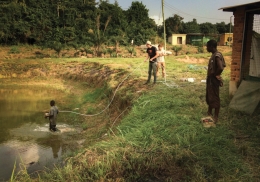Student designs improve fish farms in Africa

The Grand Challenge facing agriculture is how to feed 9 billion people by mid-century. Students in OSU’s College of Agricultural Sciences are meeting that challenge with innovations to help African fish farmers produce food efficiently and sustainably.
According to the United Nations Food and Agriculture Organization, 1 billion people, largely in developing countries, rely on fish as their primary source of animal protein. As stocks of wild fish dwindle worldwide, fish farming could help meet the increasing demand for food by a growing global population.
Partnering with the Aquafish Innovation Lab at Oregon State, students in the Biological and Ecological Engineering department are using their Senior Design capstone course to design a low-cost, off-the-grid aeration system for small, rural fish ponds.
For more than 25 years, Aquafish Innovation Lab’s director Hillary Egna has focused her work on sustainable, small-scale fisheries and aquaculture in developing countries. Sharing with students her experiences with African fish farmers and her long-standing relationships with African fisheries scientists, Egna introduced the students to a vexing problem: how to provide oxygen to an open pond where tilapia are raised for human consumption in a location where line-power electricity is not available. The students took up the challenge.
[caption caption="Farm workers in Ghana help install a new pond aeration system designed by OSU student Dillon George. (Photo by John Selker.)"]  [/caption]
[/caption]
Ecological Engineering’s Senior Design course challenges students to use all the skills they’ve learned to solve the kinds of complex, open-ended design problems they are likely to encounter in ecological engineering practice. This is the third year that the course has addressed this challenge from the Aquafish Innovation Lab. Egna keeps the students focused on big-picture goals and real-world limitations. Faculty from the Biological and Ecological Engineering department advise the students on technical aspects. Five months of class time, and many nights and weekends, result in an array of potential designs.
The first year, Egna and others judged the students’ prototypes and chose two designs to field test in Ghana. The students travelled there in August 2015 with their OSU professor Ganti Murthy to work with colleagues at Kwame Nkrumah University of Science and Technology (KNUST) in Kumsai, Ghana. They installed their designs in separate ponds, monitored their effectiveness, and instructed the KNUST students on the maintenance and functionality of the aeration devices.
“The KNUST faculty and students really made the implementation of our designs possible,” said Dylan Ferrell, one of the students who designed improvements to the system in Ghana. “It’s one thing to design something thousands of miles away, but it’s entirely different to implement it in a real-world setting.”
As with most innovative ideas, once these were implemented, their designers saw the need for improvements. So, the following year’s Senior Design Course took up the challenge to further improve the pond aerator design. In August 2016, three more students traveled to Ghana with ecological engineering professor John Selker to install design improvements that allow the system to run independent of energy fluctuations.
“This design challenge benefits ecological engineering students and faculty here at OSU and the students and faculty at KNUST in Ghana,” said Dillon George, another student on the Ghana design team. “The bigger picture is to improve the efficacy of aquaculture as an industry in rural tropical and subtropical nations across the developing world.”
